Operation Management Assignment: Production Design and Strategies
VerifiedAdded on 2022/08/11
|7
|1635
|47
Homework Assignment
AI Summary
This assignment delves into the core concepts of operation management by analyzing three distinct industries: paper manufacturing, interior design, and soap production. The paper manufacturing section outlines the preparatory, pulp-making, and paper-making stages, highlighting key operational decisions. The interior design segment dissects the five stages of an internal design firm's production system, emphasizing strategic planning, concept development, design development, construction documentation, and construction administration. The assignment then addresses the transition from a batch process to an assembly-line process, discussing relevant concerns such as production quantity, material waste, and timeframe. Finally, the soap industry's production process is examined, detailing the raw material selection, saponification process, and manufacturing stages. The assignment provides a comprehensive overview of production design, process-flow analysis, and operations strategies in these varied business contexts.
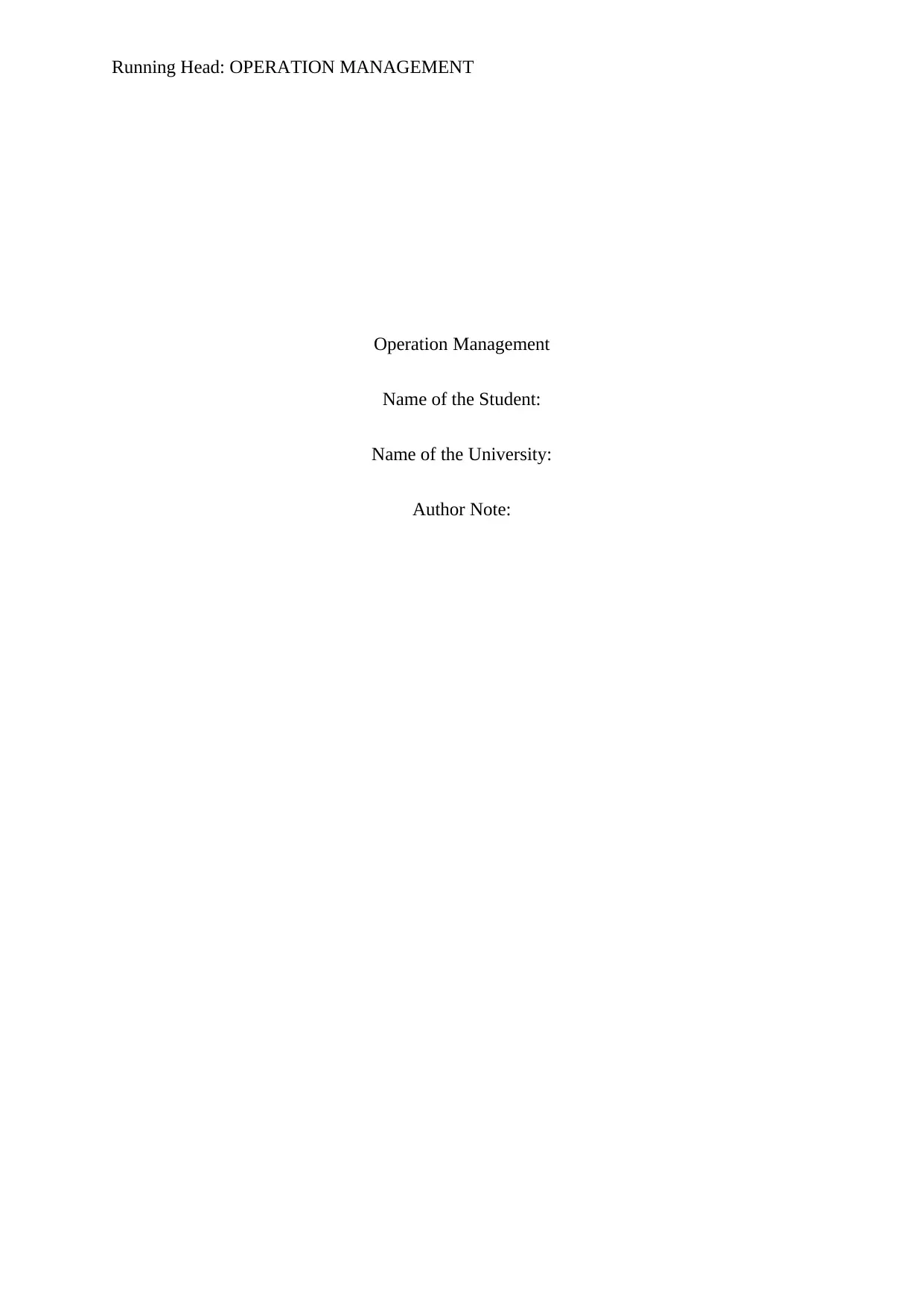
Running Head: OPERATION MANAGEMENT
Operation Management
Name of the Student:
Name of the University:
Author Note:
Operation Management
Name of the Student:
Name of the University:
Author Note:
Paraphrase This Document
Need a fresh take? Get an instant paraphrase of this document with our AI Paraphraser
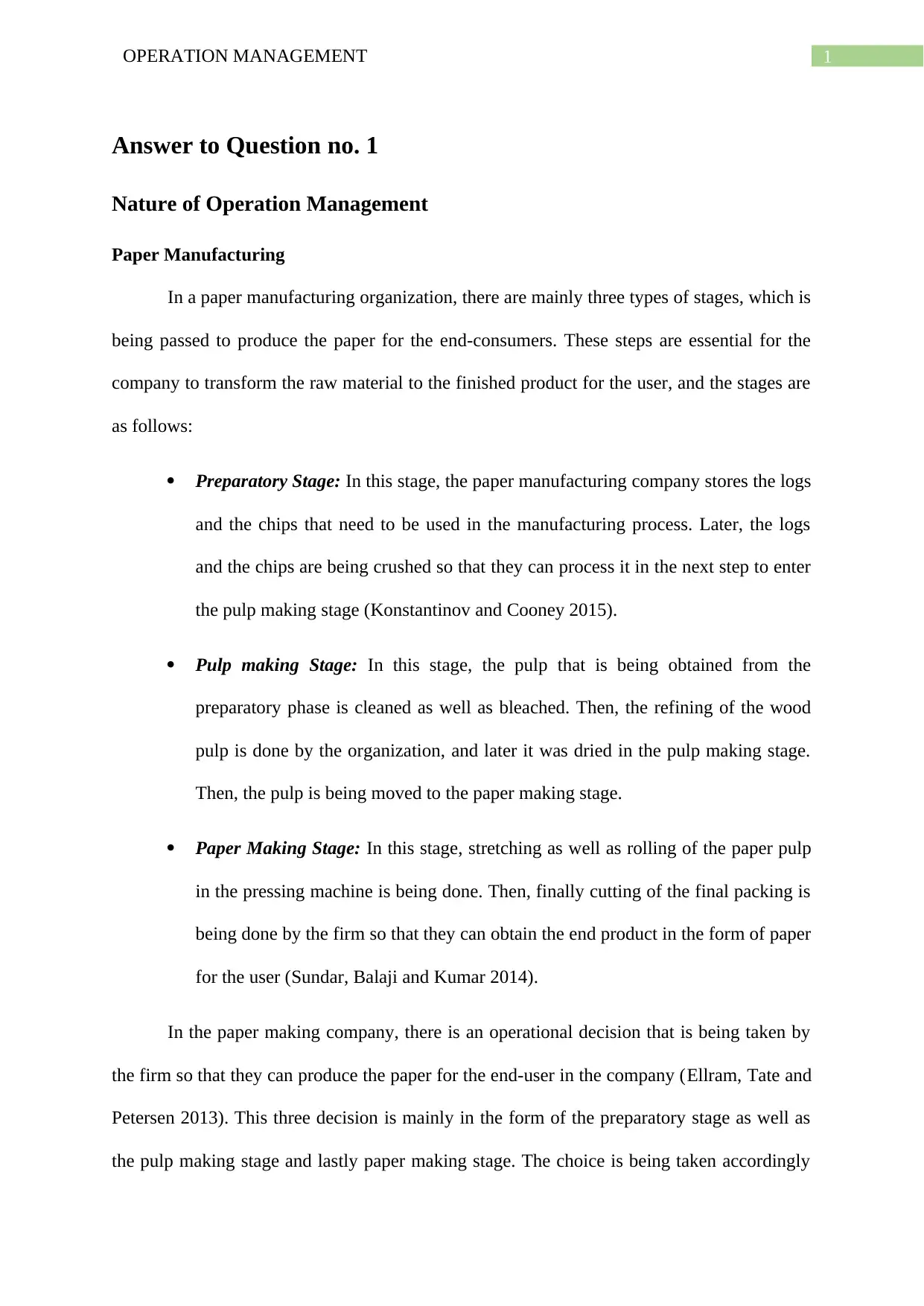
1OPERATION MANAGEMENT
Answer to Question no. 1
Nature of Operation Management
Paper Manufacturing
In a paper manufacturing organization, there are mainly three types of stages, which is
being passed to produce the paper for the end-consumers. These steps are essential for the
company to transform the raw material to the finished product for the user, and the stages are
as follows:
Preparatory Stage: In this stage, the paper manufacturing company stores the logs
and the chips that need to be used in the manufacturing process. Later, the logs
and the chips are being crushed so that they can process it in the next step to enter
the pulp making stage (Konstantinov and Cooney 2015).
Pulp making Stage: In this stage, the pulp that is being obtained from the
preparatory phase is cleaned as well as bleached. Then, the refining of the wood
pulp is done by the organization, and later it was dried in the pulp making stage.
Then, the pulp is being moved to the paper making stage.
Paper Making Stage: In this stage, stretching as well as rolling of the paper pulp
in the pressing machine is being done. Then, finally cutting of the final packing is
being done by the firm so that they can obtain the end product in the form of paper
for the user (Sundar, Balaji and Kumar 2014).
In the paper making company, there is an operational decision that is being taken by
the firm so that they can produce the paper for the end-user in the company (Ellram, Tate and
Petersen 2013). This three decision is mainly in the form of the preparatory stage as well as
the pulp making stage and lastly paper making stage. The choice is being taken accordingly
Answer to Question no. 1
Nature of Operation Management
Paper Manufacturing
In a paper manufacturing organization, there are mainly three types of stages, which is
being passed to produce the paper for the end-consumers. These steps are essential for the
company to transform the raw material to the finished product for the user, and the stages are
as follows:
Preparatory Stage: In this stage, the paper manufacturing company stores the logs
and the chips that need to be used in the manufacturing process. Later, the logs
and the chips are being crushed so that they can process it in the next step to enter
the pulp making stage (Konstantinov and Cooney 2015).
Pulp making Stage: In this stage, the pulp that is being obtained from the
preparatory phase is cleaned as well as bleached. Then, the refining of the wood
pulp is done by the organization, and later it was dried in the pulp making stage.
Then, the pulp is being moved to the paper making stage.
Paper Making Stage: In this stage, stretching as well as rolling of the paper pulp
in the pressing machine is being done. Then, finally cutting of the final packing is
being done by the firm so that they can obtain the end product in the form of paper
for the user (Sundar, Balaji and Kumar 2014).
In the paper making company, there is an operational decision that is being taken by
the firm so that they can produce the paper for the end-user in the company (Ellram, Tate and
Petersen 2013). This three decision is mainly in the form of the preparatory stage as well as
the pulp making stage and lastly paper making stage. The choice is being taken accordingly
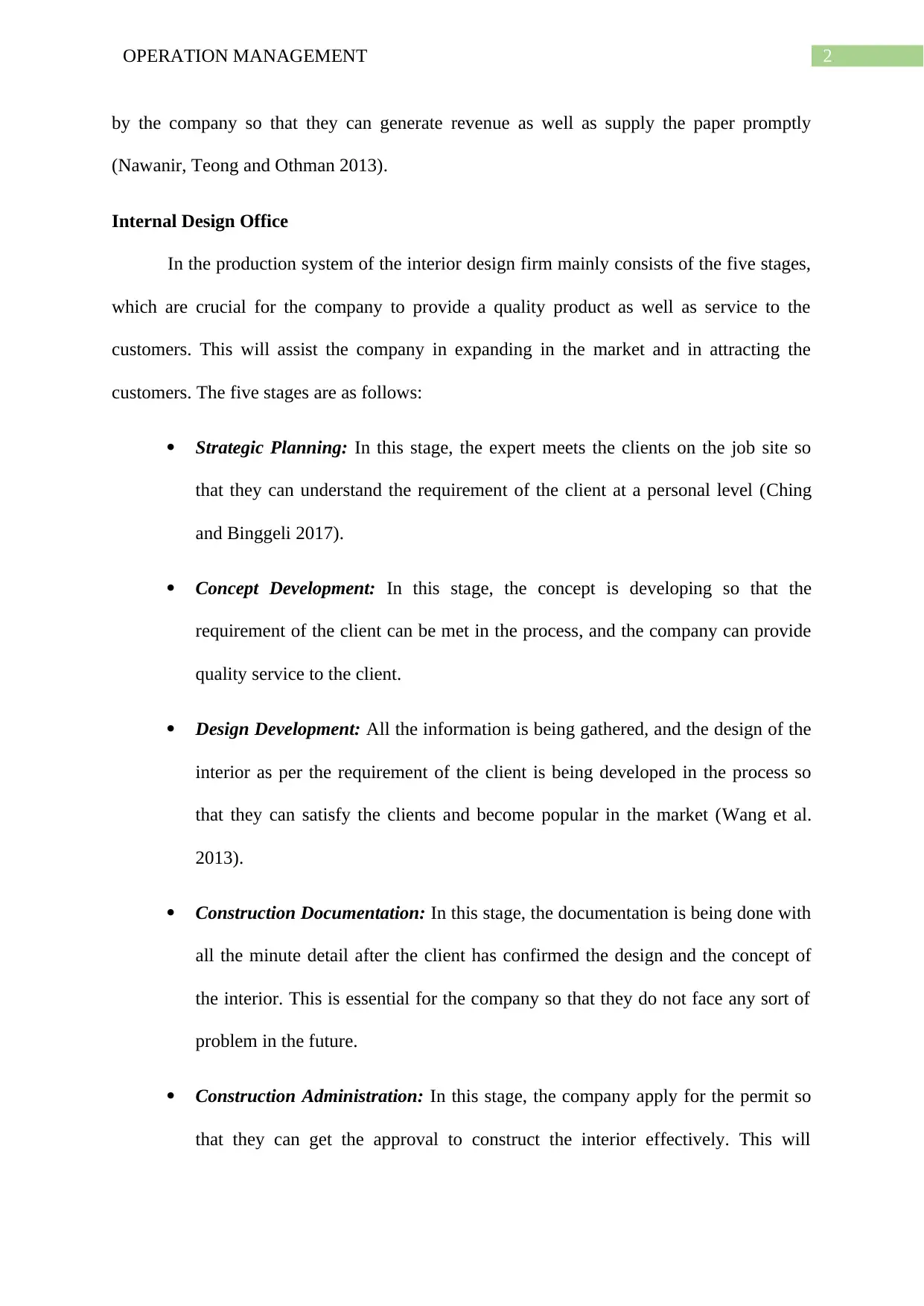
2OPERATION MANAGEMENT
by the company so that they can generate revenue as well as supply the paper promptly
(Nawanir, Teong and Othman 2013).
Internal Design Office
In the production system of the interior design firm mainly consists of the five stages,
which are crucial for the company to provide a quality product as well as service to the
customers. This will assist the company in expanding in the market and in attracting the
customers. The five stages are as follows:
Strategic Planning: In this stage, the expert meets the clients on the job site so
that they can understand the requirement of the client at a personal level (Ching
and Binggeli 2017).
Concept Development: In this stage, the concept is developing so that the
requirement of the client can be met in the process, and the company can provide
quality service to the client.
Design Development: All the information is being gathered, and the design of the
interior as per the requirement of the client is being developed in the process so
that they can satisfy the clients and become popular in the market (Wang et al.
2013).
Construction Documentation: In this stage, the documentation is being done with
all the minute detail after the client has confirmed the design and the concept of
the interior. This is essential for the company so that they do not face any sort of
problem in the future.
Construction Administration: In this stage, the company apply for the permit so
that they can get the approval to construct the interior effectively. This will
by the company so that they can generate revenue as well as supply the paper promptly
(Nawanir, Teong and Othman 2013).
Internal Design Office
In the production system of the interior design firm mainly consists of the five stages,
which are crucial for the company to provide a quality product as well as service to the
customers. This will assist the company in expanding in the market and in attracting the
customers. The five stages are as follows:
Strategic Planning: In this stage, the expert meets the clients on the job site so
that they can understand the requirement of the client at a personal level (Ching
and Binggeli 2017).
Concept Development: In this stage, the concept is developing so that the
requirement of the client can be met in the process, and the company can provide
quality service to the client.
Design Development: All the information is being gathered, and the design of the
interior as per the requirement of the client is being developed in the process so
that they can satisfy the clients and become popular in the market (Wang et al.
2013).
Construction Documentation: In this stage, the documentation is being done with
all the minute detail after the client has confirmed the design and the concept of
the interior. This is essential for the company so that they do not face any sort of
problem in the future.
Construction Administration: In this stage, the company apply for the permit so
that they can get the approval to construct the interior effectively. This will
⊘ This is a preview!⊘
Do you want full access?
Subscribe today to unlock all pages.

Trusted by 1+ million students worldwide
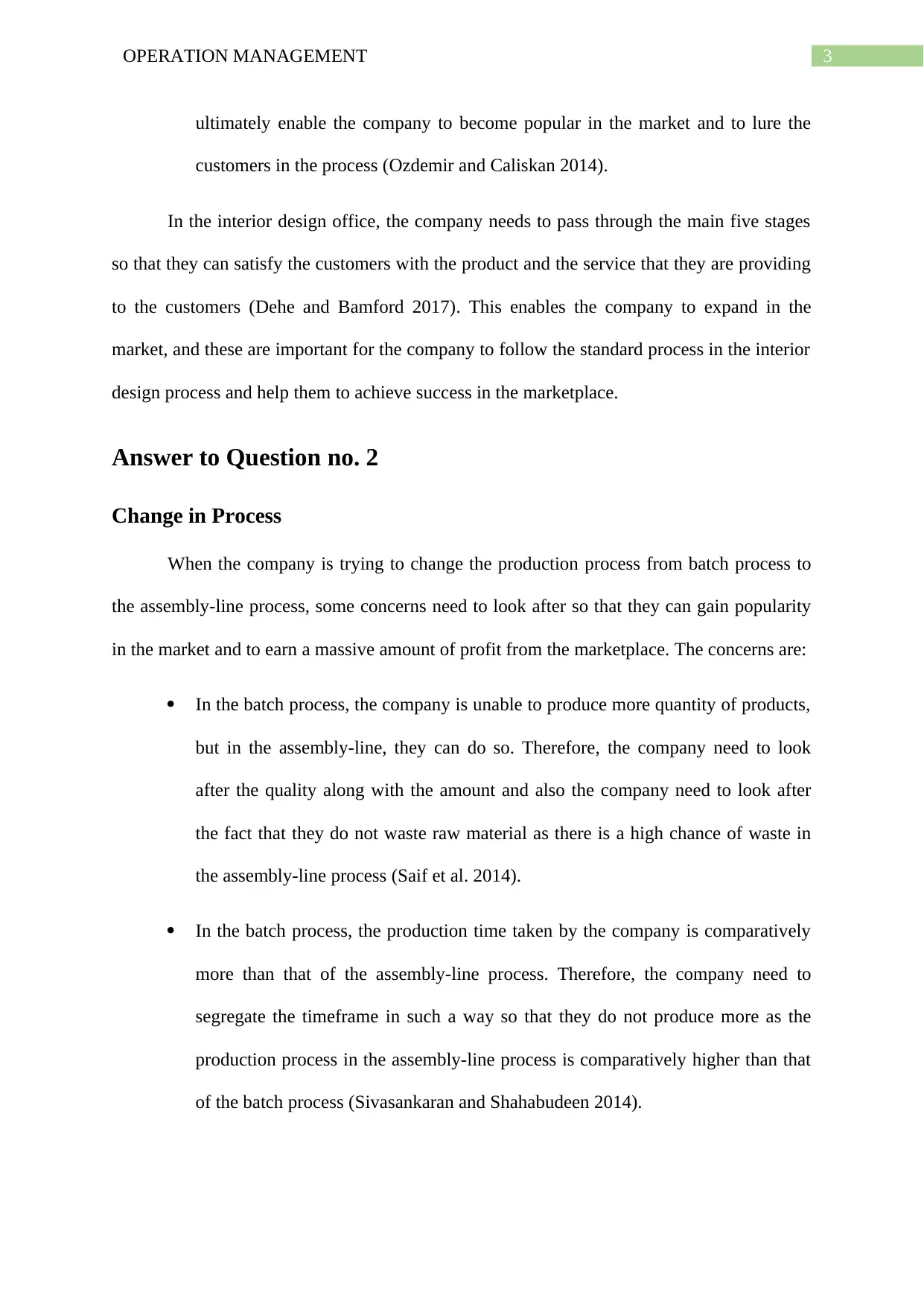
3OPERATION MANAGEMENT
ultimately enable the company to become popular in the market and to lure the
customers in the process (Ozdemir and Caliskan 2014).
In the interior design office, the company needs to pass through the main five stages
so that they can satisfy the customers with the product and the service that they are providing
to the customers (Dehe and Bamford 2017). This enables the company to expand in the
market, and these are important for the company to follow the standard process in the interior
design process and help them to achieve success in the marketplace.
Answer to Question no. 2
Change in Process
When the company is trying to change the production process from batch process to
the assembly-line process, some concerns need to look after so that they can gain popularity
in the market and to earn a massive amount of profit from the marketplace. The concerns are:
In the batch process, the company is unable to produce more quantity of products,
but in the assembly-line, they can do so. Therefore, the company need to look
after the quality along with the amount and also the company need to look after
the fact that they do not waste raw material as there is a high chance of waste in
the assembly-line process (Saif et al. 2014).
In the batch process, the production time taken by the company is comparatively
more than that of the assembly-line process. Therefore, the company need to
segregate the timeframe in such a way so that they do not produce more as the
production process in the assembly-line process is comparatively higher than that
of the batch process (Sivasankaran and Shahabudeen 2014).
ultimately enable the company to become popular in the market and to lure the
customers in the process (Ozdemir and Caliskan 2014).
In the interior design office, the company needs to pass through the main five stages
so that they can satisfy the customers with the product and the service that they are providing
to the customers (Dehe and Bamford 2017). This enables the company to expand in the
market, and these are important for the company to follow the standard process in the interior
design process and help them to achieve success in the marketplace.
Answer to Question no. 2
Change in Process
When the company is trying to change the production process from batch process to
the assembly-line process, some concerns need to look after so that they can gain popularity
in the market and to earn a massive amount of profit from the marketplace. The concerns are:
In the batch process, the company is unable to produce more quantity of products,
but in the assembly-line, they can do so. Therefore, the company need to look
after the quality along with the amount and also the company need to look after
the fact that they do not waste raw material as there is a high chance of waste in
the assembly-line process (Saif et al. 2014).
In the batch process, the production time taken by the company is comparatively
more than that of the assembly-line process. Therefore, the company need to
segregate the timeframe in such a way so that they do not produce more as the
production process in the assembly-line process is comparatively higher than that
of the batch process (Sivasankaran and Shahabudeen 2014).
Paraphrase This Document
Need a fresh take? Get an instant paraphrase of this document with our AI Paraphraser
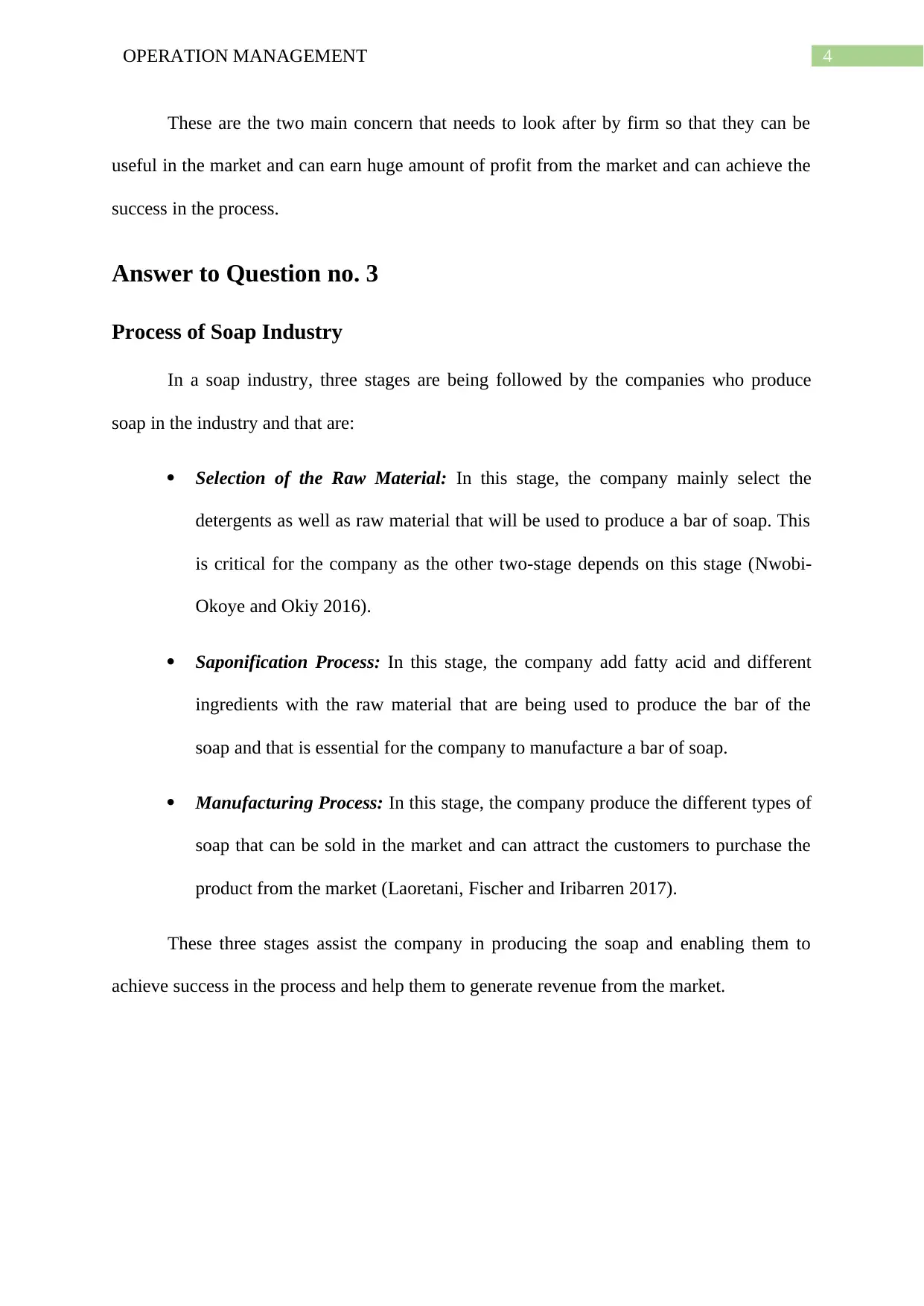
4OPERATION MANAGEMENT
These are the two main concern that needs to look after by firm so that they can be
useful in the market and can earn huge amount of profit from the market and can achieve the
success in the process.
Answer to Question no. 3
Process of Soap Industry
In a soap industry, three stages are being followed by the companies who produce
soap in the industry and that are:
Selection of the Raw Material: In this stage, the company mainly select the
detergents as well as raw material that will be used to produce a bar of soap. This
is critical for the company as the other two-stage depends on this stage (Nwobi-
Okoye and Okiy 2016).
Saponification Process: In this stage, the company add fatty acid and different
ingredients with the raw material that are being used to produce the bar of the
soap and that is essential for the company to manufacture a bar of soap.
Manufacturing Process: In this stage, the company produce the different types of
soap that can be sold in the market and can attract the customers to purchase the
product from the market (Laoretani, Fischer and Iribarren 2017).
These three stages assist the company in producing the soap and enabling them to
achieve success in the process and help them to generate revenue from the market.
These are the two main concern that needs to look after by firm so that they can be
useful in the market and can earn huge amount of profit from the market and can achieve the
success in the process.
Answer to Question no. 3
Process of Soap Industry
In a soap industry, three stages are being followed by the companies who produce
soap in the industry and that are:
Selection of the Raw Material: In this stage, the company mainly select the
detergents as well as raw material that will be used to produce a bar of soap. This
is critical for the company as the other two-stage depends on this stage (Nwobi-
Okoye and Okiy 2016).
Saponification Process: In this stage, the company add fatty acid and different
ingredients with the raw material that are being used to produce the bar of the
soap and that is essential for the company to manufacture a bar of soap.
Manufacturing Process: In this stage, the company produce the different types of
soap that can be sold in the market and can attract the customers to purchase the
product from the market (Laoretani, Fischer and Iribarren 2017).
These three stages assist the company in producing the soap and enabling them to
achieve success in the process and help them to generate revenue from the market.
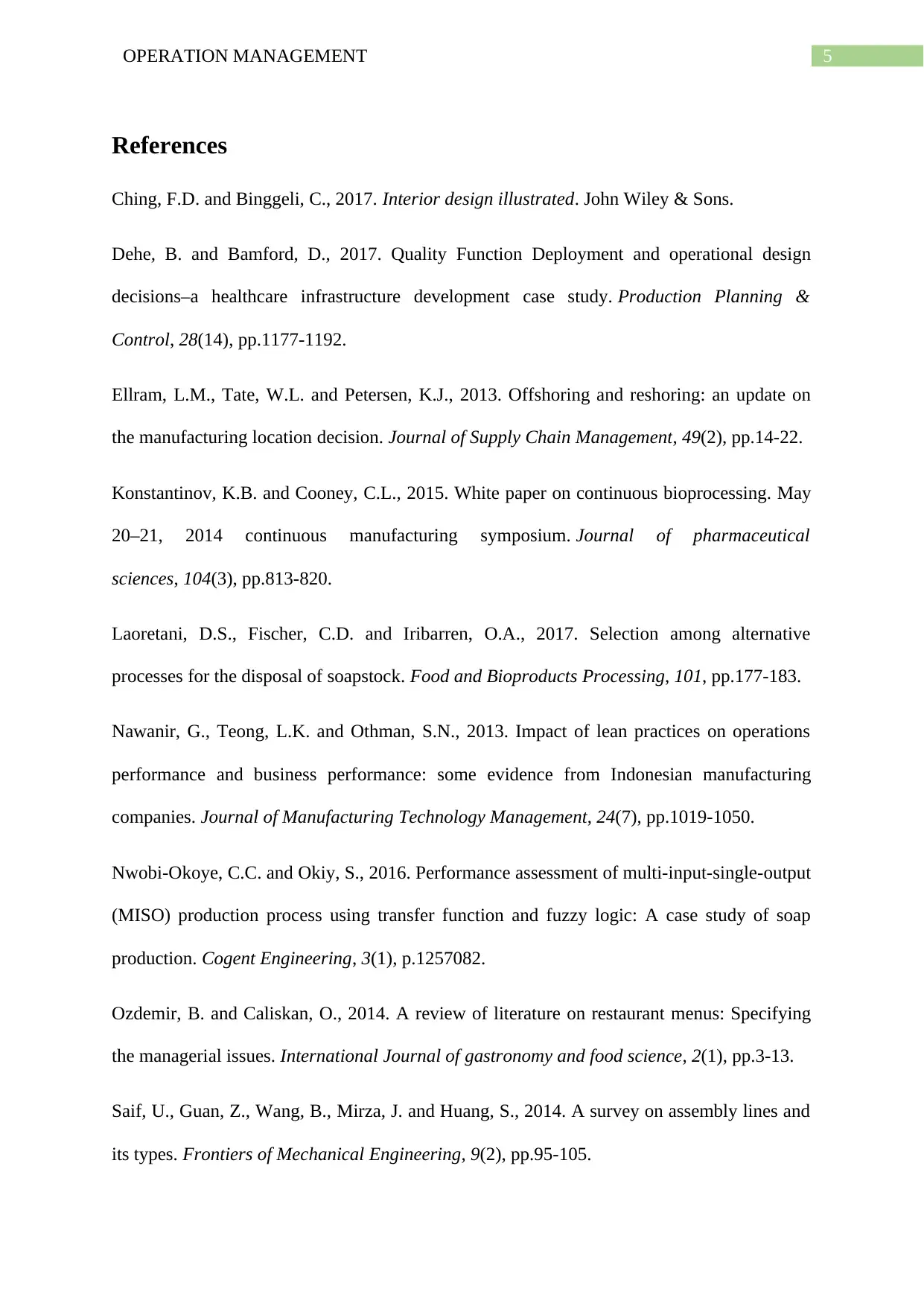
5OPERATION MANAGEMENT
References
Ching, F.D. and Binggeli, C., 2017. Interior design illustrated. John Wiley & Sons.
Dehe, B. and Bamford, D., 2017. Quality Function Deployment and operational design
decisions–a healthcare infrastructure development case study. Production Planning &
Control, 28(14), pp.1177-1192.
Ellram, L.M., Tate, W.L. and Petersen, K.J., 2013. Offshoring and reshoring: an update on
the manufacturing location decision. Journal of Supply Chain Management, 49(2), pp.14-22.
Konstantinov, K.B. and Cooney, C.L., 2015. White paper on continuous bioprocessing. May
20–21, 2014 continuous manufacturing symposium. Journal of pharmaceutical
sciences, 104(3), pp.813-820.
Laoretani, D.S., Fischer, C.D. and Iribarren, O.A., 2017. Selection among alternative
processes for the disposal of soapstock. Food and Bioproducts Processing, 101, pp.177-183.
Nawanir, G., Teong, L.K. and Othman, S.N., 2013. Impact of lean practices on operations
performance and business performance: some evidence from Indonesian manufacturing
companies. Journal of Manufacturing Technology Management, 24(7), pp.1019-1050.
Nwobi-Okoye, C.C. and Okiy, S., 2016. Performance assessment of multi-input-single-output
(MISO) production process using transfer function and fuzzy logic: A case study of soap
production. Cogent Engineering, 3(1), p.1257082.
Ozdemir, B. and Caliskan, O., 2014. A review of literature on restaurant menus: Specifying
the managerial issues. International Journal of gastronomy and food science, 2(1), pp.3-13.
Saif, U., Guan, Z., Wang, B., Mirza, J. and Huang, S., 2014. A survey on assembly lines and
its types. Frontiers of Mechanical Engineering, 9(2), pp.95-105.
References
Ching, F.D. and Binggeli, C., 2017. Interior design illustrated. John Wiley & Sons.
Dehe, B. and Bamford, D., 2017. Quality Function Deployment and operational design
decisions–a healthcare infrastructure development case study. Production Planning &
Control, 28(14), pp.1177-1192.
Ellram, L.M., Tate, W.L. and Petersen, K.J., 2013. Offshoring and reshoring: an update on
the manufacturing location decision. Journal of Supply Chain Management, 49(2), pp.14-22.
Konstantinov, K.B. and Cooney, C.L., 2015. White paper on continuous bioprocessing. May
20–21, 2014 continuous manufacturing symposium. Journal of pharmaceutical
sciences, 104(3), pp.813-820.
Laoretani, D.S., Fischer, C.D. and Iribarren, O.A., 2017. Selection among alternative
processes for the disposal of soapstock. Food and Bioproducts Processing, 101, pp.177-183.
Nawanir, G., Teong, L.K. and Othman, S.N., 2013. Impact of lean practices on operations
performance and business performance: some evidence from Indonesian manufacturing
companies. Journal of Manufacturing Technology Management, 24(7), pp.1019-1050.
Nwobi-Okoye, C.C. and Okiy, S., 2016. Performance assessment of multi-input-single-output
(MISO) production process using transfer function and fuzzy logic: A case study of soap
production. Cogent Engineering, 3(1), p.1257082.
Ozdemir, B. and Caliskan, O., 2014. A review of literature on restaurant menus: Specifying
the managerial issues. International Journal of gastronomy and food science, 2(1), pp.3-13.
Saif, U., Guan, Z., Wang, B., Mirza, J. and Huang, S., 2014. A survey on assembly lines and
its types. Frontiers of Mechanical Engineering, 9(2), pp.95-105.
⊘ This is a preview!⊘
Do you want full access?
Subscribe today to unlock all pages.

Trusted by 1+ million students worldwide
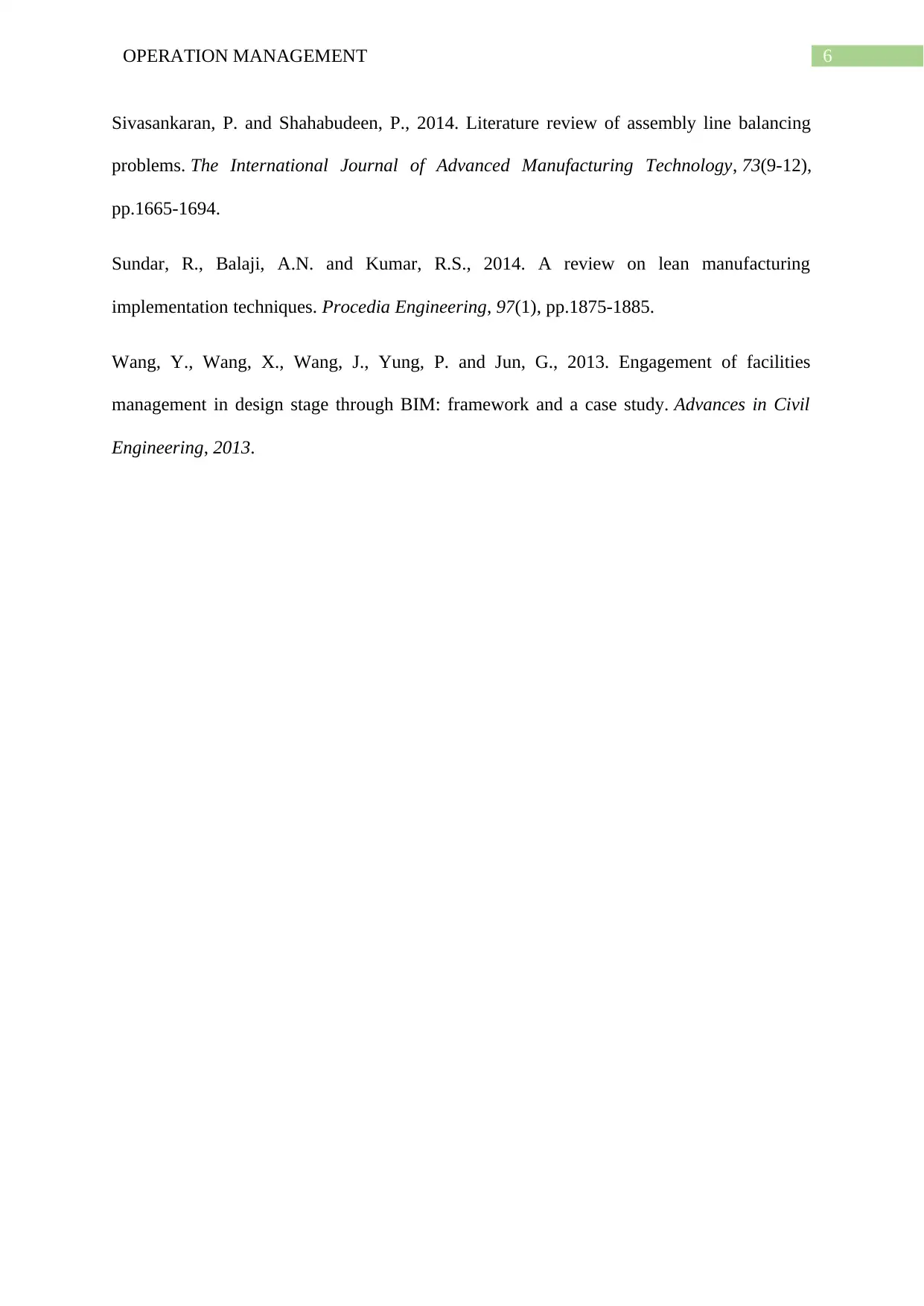
6OPERATION MANAGEMENT
Sivasankaran, P. and Shahabudeen, P., 2014. Literature review of assembly line balancing
problems. The International Journal of Advanced Manufacturing Technology, 73(9-12),
pp.1665-1694.
Sundar, R., Balaji, A.N. and Kumar, R.S., 2014. A review on lean manufacturing
implementation techniques. Procedia Engineering, 97(1), pp.1875-1885.
Wang, Y., Wang, X., Wang, J., Yung, P. and Jun, G., 2013. Engagement of facilities
management in design stage through BIM: framework and a case study. Advances in Civil
Engineering, 2013.
Sivasankaran, P. and Shahabudeen, P., 2014. Literature review of assembly line balancing
problems. The International Journal of Advanced Manufacturing Technology, 73(9-12),
pp.1665-1694.
Sundar, R., Balaji, A.N. and Kumar, R.S., 2014. A review on lean manufacturing
implementation techniques. Procedia Engineering, 97(1), pp.1875-1885.
Wang, Y., Wang, X., Wang, J., Yung, P. and Jun, G., 2013. Engagement of facilities
management in design stage through BIM: framework and a case study. Advances in Civil
Engineering, 2013.
1 out of 7
Related Documents
Your All-in-One AI-Powered Toolkit for Academic Success.
+13062052269
info@desklib.com
Available 24*7 on WhatsApp / Email
![[object Object]](/_next/static/media/star-bottom.7253800d.svg)
Unlock your academic potential
Copyright © 2020–2025 A2Z Services. All Rights Reserved. Developed and managed by ZUCOL.




